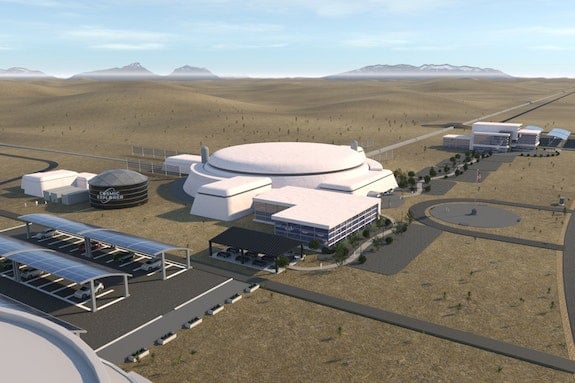Next-generation gravitational wave detectors capable of revealing processes from the creation of our Universe obtainable by no other means are being developed by UK astronomers.

Artist impression of the Cosmic Explorer project in development in the United States of America. Credit: A. Nguyen, V. Kitchen, E. Anaya, California State University Fullerton
Researchers from seven UK universities including Cardiff University, will develop designs for new mirror coatings, data analysis techniques, and suspension and seismic isolation systems for use in two future international gravitational wave detector projects.
Currently in development, the Cosmic Explorer (CE) project in the United States and the Einstein Telescope (ET) project in Europe, are expected to be completed and online by 2040.
The consortium of UK universities secured £7m in funding from the UK Research and Innovation Infrastructure Fund to support the work. The fund helps to create a long-term pipeline of infrastructure investment priorities and supports the facilities, equipment and resources that are essential for researchers and innovators to do ground-breaking work.
Professor Stephen Fairhurst, Cardiff University’s lead and director of the Gravity Exploration Institute at the School of Physics and Astronomy, said: “The UK Involvement in the next-generation gravitational wave observatory will secure long-standing UK leadership in the field, in both instrument development and scientific exploitation. It will enhance our cutting-edge capability in quantum technologies and advanced data analysis and machine learning techniques.”
Gravitational wave detectors work by bouncing lasers between mirrors suspended at each end of long pipes often arranged in an L-shape.
The gravitational waves – faint ripples in spacetime caused by enormous astronomical events like the collision of black holes – pass through the detectors creating miniscule variations in the distance between the mirrors measured by the lasers.
Analysis of the data captured during this process can reveal a wealth of information about their origins in space.
Significantly more ambitious in their design than previous detectors, those used on CE and ET are expected to detect signals from the very edge of the universe.
Astronomers say this will enable them to study regions of the Universe that electromagnetic observations cannot explore and potentially uncover cosmic history dating back to before the birth of the first stars.
Professor Mark Hannam, Deputy Head of the Gravity Exploration Institute at Cardiff University’s School of Physics and Astronomy, added: “To make these discoveries we also need a huge increase in our theoretical understanding of the signals. One of the things we need to do now is work out where the most exciting discoveries might lie, and what we need to calculate so we can make them.”
The next generation detectors will bounce lasers between suspended mirrors free of external vibration and placed up to 40km apart – over 10 times the distance travelled in current detectors.
The mirrors will also be bigger and heavier as they double in diameter to around 60cm.
The expanded reach of the detectors will help cast new light on how black holes were formed in the earliest epochs of time, how matter behaves in neutron stars, and pick up gravitational waves which current observatories are unable to detect.
Dr Keiko Kokeyama, a Lecturer at Cardiff University’s School of Physics and Astronomy, said: “To upgrade the detectors’ sensitivity, radically new technological solutions across all detector subsystems will be required. We will develop new types of optics that can optimise detector output for target sensitivity.”
Cardiff University scientists, funded by the Science and Technology Facilities Council, have been involved in gravitational wave research for several decades.
They contributed to the design, mirror suspension technology and data analysis which underpins the current generation of gravitational wave observatories – LIGO in the United States, Virgo in Italy, and KAGRA in Japan.
The LIGO observatory made the historic first detection of gravitational waves in 2015, opening up an entirely new field of astronomy which ‘listens’ for vibrations in spacetime instead of looking for information from across the electromagnetic spectrum.
Since 2015, gravitational wave detectors have made spectacular discoveries – including of signals from more than 100 pairs of colliding black holes.
Source: Cardiff University

